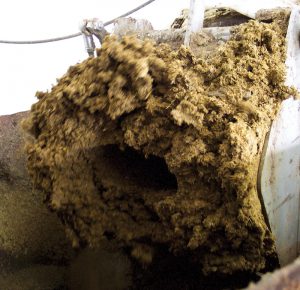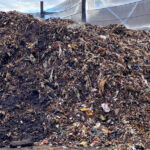Green Mountain Power is investing in solar, anaerobic digestion and energy efficiency systems to build a more reliant grid, and comply with the state’s renewable energy requirements.
Nora Goldstein
BioCycle September 2015

Thirteen farms with anaerobic digesters are enrolled in GMP’s Cow Power program, producing about 19,000 MWh of renewable energy annually. Monument Farms Dairy in Weybridge, Vermont is a Cow Power producer.
The State of Vermont’s legislature has been quite busy over the past few years passing laws that, when taken all together, create opportunities for organics recycling systems and services. Act 148, the Universal Recycling Law enacted in 2012, requires that all organics be diverted from disposal by 2020. Act 64, passed by the legislature in 2015, focuses on significantly improving water quality in the Lake Champlain Basin. For the first time, small farms will have to comply with pollution regulations. And the passage of Act 56 in 2015 establishes a Renewable Energy Standard that requires utilities to meet a 75 percent total renewable energy requirement by 2032 (and an interim goal of 55% in 2017). A utility may meet this requirement by owning renewable energy or renewable energy credits (RECs) from any plant, as long as the plant’s energy is capable of delivery to New England.
This convergence of policies is good news to Green Mountain Power, a Vermont electric utility that has already invested significantly in renewables as well as smart grid technologies and distributed energy systems. Green Mountain Power (GMP) delivers close to 80 percent of all electricity consumed in Vermont annually, serving approximately 265,000 residential and business customers in the state. The utility is owned by Gaz Métro, a Canadian company.
Community Digesters
In 2012, GMP merged with Central Vermont Public Service (CVPS), which created the Cow Power program in 2004. Cow Power is a Voluntary Renewable Tariff that offered then CVPS’ customers to voluntarily sign on to purchase all or a portion of their electricity from farm-generated renewable energy produced by farms with anaerobic digesters enrolled in CVPS’ green energy program. GMP continued the Cow Power program, which today has 13 farms enrolled, producing about 19,000 MWh of renewable energy annually or enough energy for about 3,200 average Vermont homes — a little over one percent of the homes in all of Vermont (based on 2014 Census of Vermont Housing Units).
The latest frontier for GMP is to build, own and operate community digesters. And this is where the convergence of policies comes into play. Dairy farms will be facing increasing pressure to manage nutrients under Act 64. More processing infrastructure is needed to comply with the Act 148 organics disposal ban (see box). And utilities like GMP are required to deliver 55 percent of their electricity in the form of renewable energy within two years.
“The adjustment to Vermont’s renewable energy policies, as well as the renewed urgency on water quality, leads me to believe that we will see more utility-owned digesters,” notes David Dunn, a project manager at Green Mountain Power. “Right now, with the low price of milk — and the absence of previously significant federal funding to construct digesters — dairy farmers will put their money into their business of cows, crops and quality milk. Having Green Mountain Power own digesters that will process manure from their farms, and sharing the benefits such as animal bedding and digested manure effluent with reduced odors, is an attractive proposition.”
Green Mountain Power’s first community digester is being sited in St. Albans, Vermont. The St. Albans Bay has among the highest phosphorus export rates in the Lake Champlain Basin, and therefore has a very restrictive Total Maximum Daily Load (TMDL) set by the U.S. EPA with phosphorus as the limiting nutrient. “We have selected a site on a farm where there are about 4,000 cows within a few mile radius,” says Dunn. “Three farms are committed, including the host farm and two others. Two of the dairies are across the street and can pump manure to the digester. We’ve selected the DVO Two-Stage, Mixed Plug Flow™ digester, and will be installing DVO’s DAF (dissolved air flotation) system to capture more of the phosphorus in a solid form.” The system will be built to accommodate 2,000 cows with the ability for expansion as needed. It will initially support a 400 kW electric generator, with a plan to produce as much as 800 kW.
Addressing Feedstock Competition
The digester is being sized to receive about 3,000 tons/year of source separated food waste, but GMP expects to start out with a bit less and grow as Act 148 expands its reach, tapping into the anticipated supply from food waste generators and municipal compliance with the law. St. Albans is in Franklin County, which is adjacent to Chittenden County, where the Chittenden Solid Waste District operates Green Mountain Compost (GMC), a 10,000 tons/year (permitted at 27,000 tpy) source separated organics composting facility that receives about 4,500 tons of food waste annually.
In January 2015, the Vermont Public Service Board (VPSB), a state agency that regulates electric utilities and sets their rates, began taking testimony on what might be the appropriate feed-in tariff (FIT) that a dairy farm-owned digester system would get under Vermont’s Standard Offer Program for electricity produced with an anaerobic digester. Rates were set for some granularity of generator size on dairy farms (less than 150 kW and greater than 150 kW), and for digesters processing food waste exclusively. The VPSB settled on $0.208 per kWh, fixed over the life of the project (set at 20 years) for digesters processing food waste exclusively. This FIT provides a substantial “subsidy” for electricity produced by anaerobic digestion of food waste, which could set up competition for feedstock between existing composting facilities and yet-to-be-built food waste digesters. Currently, farm based digesters can accept some food processing waste, and the State is working on permitting needed for farm based digesters to accept food waste envisioned by Act 148.
“Our concern is that our solid waste district and others have responsibility over a wider ranging variety of materials in the solid waste system than just food waste,” notes Tom Moreau, General Manager of the Chittenden Solid Waste District (CSWD). “We had already spent $2.3 million to build a new composting facility [Green Mountain Compost] that handles not only food waste but also thousands of tons/year of leaves and yard trimmings. If the food waste was diverted to an anaerobic digester receiving this subsidy, then we would not have sufficient nitrogen from the food waste to compost our leaves and yard trimmings.”
Vermont’s solid waste management districts already had some measure of input and control for this type of situation because the existing Vermont statutes pertaining to energy state that any waste to energy facility located in a county also had to be included in the county’s solid waste plan. “What we were able to negotiate with the new FIT was if a utility built an anaerobic digester in a different jurisdiction but then came into our county to utilize our food waste feedstock, then that action would also need to be in our solid waste management plan,” explains Moreau. “This addition was enacted as part of Act 56 this year. It exempts the first 1,000 tons of food waste. Overall, the VPSB decision to provide the $0.208 value for electricity from food waste should really help the State of Vermont achieve the organics diversion anticipated in Act 148. However it must be done in conjunction with other ongoing programs.”

Digested dairy manure fibers (similar to those in photo) are being composted at Green Mountain Compost as part of a pilot project.
With both CSWD and GMP involved in legislative activities around the FIT for food waste digesters, Moreau and Dunn had an opportunity to discuss ways that the two entities could collaborate once GMP’s community digester is up and running, as well as work together immediately with farm digesters in the Cow Power program. “We decided to conduct a pilot project to test composting of digested dairy manure fibers at Green Mountain Compost, in exchange for future testing of anaerobic digestion of a waste that GMC receives that would be challenging to compost,” notes Dunn. “We have been looking for an outlet for a portion of the digested fiber from some farms in the Cow Power program because the farms had more than they need for their own bedding.”
Green Mountain Power arranged for the delivery of 150 cubic yards (cy) of digested fiber to GMC. “We developed several different recipes, and the material is in our curing pile now,” says Dan Goossen, General Manager of GMC. “Because the fibers have been digested, the organic matter has already been broken down pretty far, so the amount we put in is pretty much the amount we are getting out. A lot of the nitrogen remains in the material.”
Green Mountain Compost has been reluctant to take in any manure following contamination of its compost from persistent herbicides in horse manure (see coverage in BioCycle archives). “We go on the assumption that all manures contain some persistent herbicides, so we sent samples of the digested fiber to the lab,” explains Goossen. “The digested fibers came back below detection levels for aminopyralid, clopyralid and picloram. We also tested for copper, as dairy farmers use copper as an agent to control hoof disease on the cows. We wanted to make sure it wouldn’t show up in our end product. A little was detected, but not enough to be a concern. The end result is that we could take more digested fiber if it made sense in terms of transportation and economics. And we are definitely willing to explore a feedstock swap, especially now that Green Mountain Power just unveiled its community digester project in St. Albans.”
Goossen adds that another benefit of incorporating digested fibers is an increase in volume of finished compost. “Everything else we process, especially food waste, decreases in volume during composting but since the fibers are already broken down, they contribute to our yields and come with nutrients. Ever since GMC stopped taking horse manure, our yields have been down but our operating expenses have stayed the same.”
Facilitating Food Waste Preprocessing
With increasing volumes of food waste to be diverted in the next few years, along with the 20.8 cents/kWh FIT for food waste digesters, several pilot projects are experimenting with technologies to slurry food waste and deliver it to farm digesters (and eventually stand-alone food waste digesters). The Vermont Clean Energy Development Fund (CEDF) requested proposals for food waste processing pilots, and ended up receiving two proposals that it wanted to fund. Green Mountain Power agreed to contribute $70,000 in addition to the roughly $200,0000 in CEDF funding to these research projects.
One grant was awarded to Casella Organics to install food waste processing equipment at its transfer station in Rutland, Vermont. Casella Organics provides collection services to organics generators in the region. “We have custom designed a system to process commercial and institutional food scraps,” explains Abbie Webb, Sustainability Manager at Casella Waste Systems, Inc. “It is not a depackaging system as we are not intending to process packaged food waste with this equipment. There is a receiving hopper for a small truck to tip into. Visible contaminants will be removed, and the food waste will pass through a magnetic separator to remove any ferrous. Then it will go to a sheer shredder to grind. We will be able to add or remove water as needed.” Casella is installing a 4,500-gallon tank, and anticipates the processing system will start up in September. For the pilot, slurried food waste will be taken to Blue Spruce Farms in Bridport, Vermont, about 35 miles from the transfer station.
The other grant was given to Grow Compost of Vermont in Moretown. Grow Compost has an organics collection service, and is working with Vermont Technical College, which began operating an anaerobic digester in 2014. With both pilot projects, research is being conducted on the amount of nutrients contained in the feedstocks going into the digester, and the amount contained in the digestate to assess the impact of adding food waste to farm digesters in Vermont. Vermont Technical College is also measuring pathogens going into and coming out of its digester.
Under Vermont Department of Environmental Conservation (DEC) regulations, farm digesters can receive food processing residuals without a solid waste certification. However AD facilities that are taking source separated commercial, institutional or residential food waste need to obtain a solid waste certification (accepting food waste up to 1% of the design capacity of the digester is allowed without a certification). For the pilot project, Casella has been issued a solid waste certification to collect and process food residuals into a pumpable slurry at its West Rutland facility prior to transport to the Blue Spruce digester. “In this case, since the pilot will be a limited duration project and Blue Spruce will be receiving a slurry directly into a reception tank (i.e., no food residuals dropped on a tipping floor or processed on-site), we’ve encouraged Blue Spruce to submit an Insignificant Waste Management Event Approval (IWMEA) application to cover the pilot activity,” explains Ben Gauthier with DEC’s Solid Waste Management Program. “Should Blue Spruce wish to continue to accept solid wastes beyond the expiration date of the IWMEA, it would need to obtain a full solid waste certification.”
Low Cost, Low Carbon
Mary Powell, Chief Executive Officer of Green Mountain Power, is a Keynote Speaker at BioCycle’s 15th Annual Conference on Renewable Energy From Organics Recycling (October 19-22, Danvers, MA). In its June 29 issue, The New Yorker magazine published an article by Bill McKibben titled “Power To The People.” McKibben interviewed Mary Powell, highlighting her commitment to taking steps to transforming the power industry in a way that benefits its customers and the climate. Powell describes herself as “customer-obsessed” and told McKibben that GMP regularly surveys its customers and the main thing Powell has learned is that “Vermonters wanted us to be as environmentally strong as possible, but they wanted us to do it without us telling them it was going to cost more money. So that became our vision: low carbon, low cost.”
As GMP develops its community digester, being “environmentally strong” and carrying out the vision of “low carbon, low cost” is front and center. “The Vermont Public Service Department (PSD) has been a big supporter of our existing Cow Power program, and understands our goal to build a community, multifarm digester,” notes Dunn. “But the PSD will push us to minimize costs and rate impacts. We are working hard to capture the value of the project’s components that can reduce nutrient loss, improve nutrient use by crops, and value the impact on water quality. It’s a piece of the story of how digesters can be part of the solution on energy, food, air, water, soil, animal well being and more.”












